Abstract
To determine whether strain-specific differences in immunoblot type, enterotoxin production, or cytotoxin production correlated with clinical presentation of Clostridium difficile infection, we evaluated isolates obtained from 428 prospectively studied hospitalized patients. Of 99 isolates available for immunoblot typing, 61 were recovered from asymptomatic carriers and 38 were from patients with C. difficile-associated diarrhea. Of 17 immunoblot types, the seven types comprising the majority of isolates (82 of 99; 83%) were variably associated with disease. Neither the presence of cytotoxin in the stool nor the production of cytotoxin or enterotoxin by isolates in vitro was significantly different for symptomatic versus asymptomatic patients. Selected host factors were more predictive of symptomatic disease than was the specific infecting C. difficile strain. These results suggest that variations in the clinical severity of C. difficile infection in different patients are not solely strain-specific phenomena related to immunoblot type or to the production of cytotoxin or enterotoxin.
Full text
PDF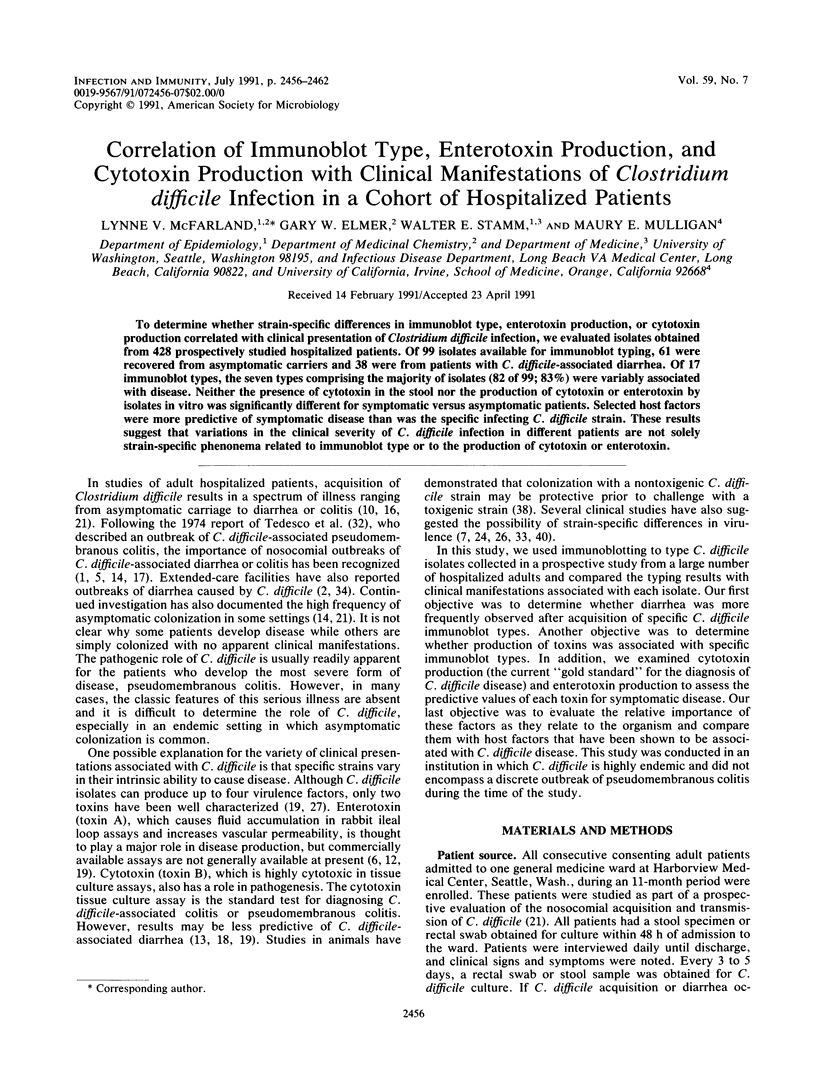
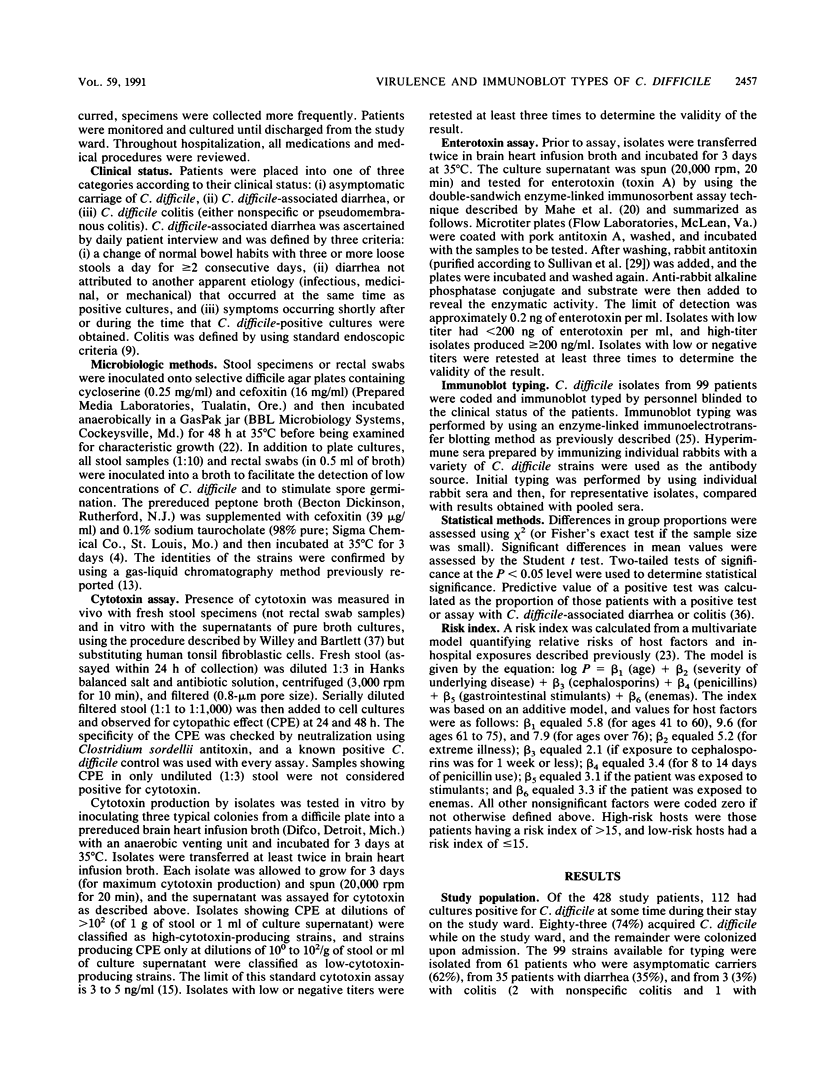
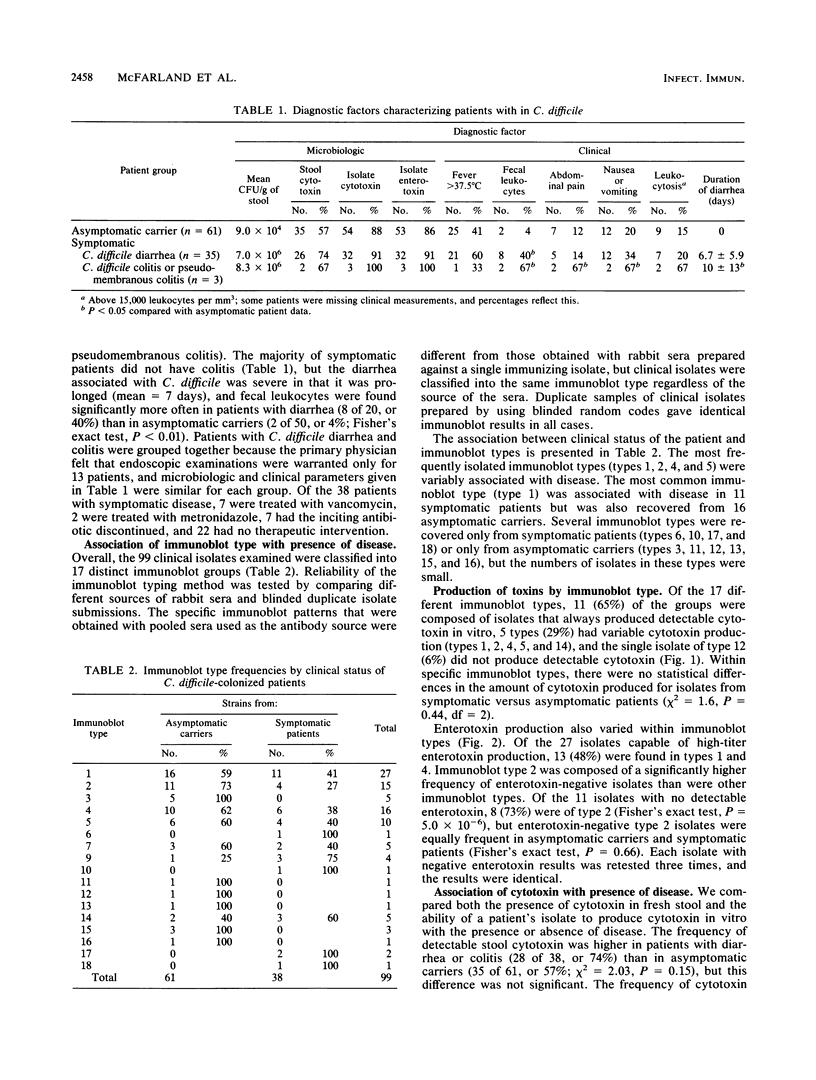
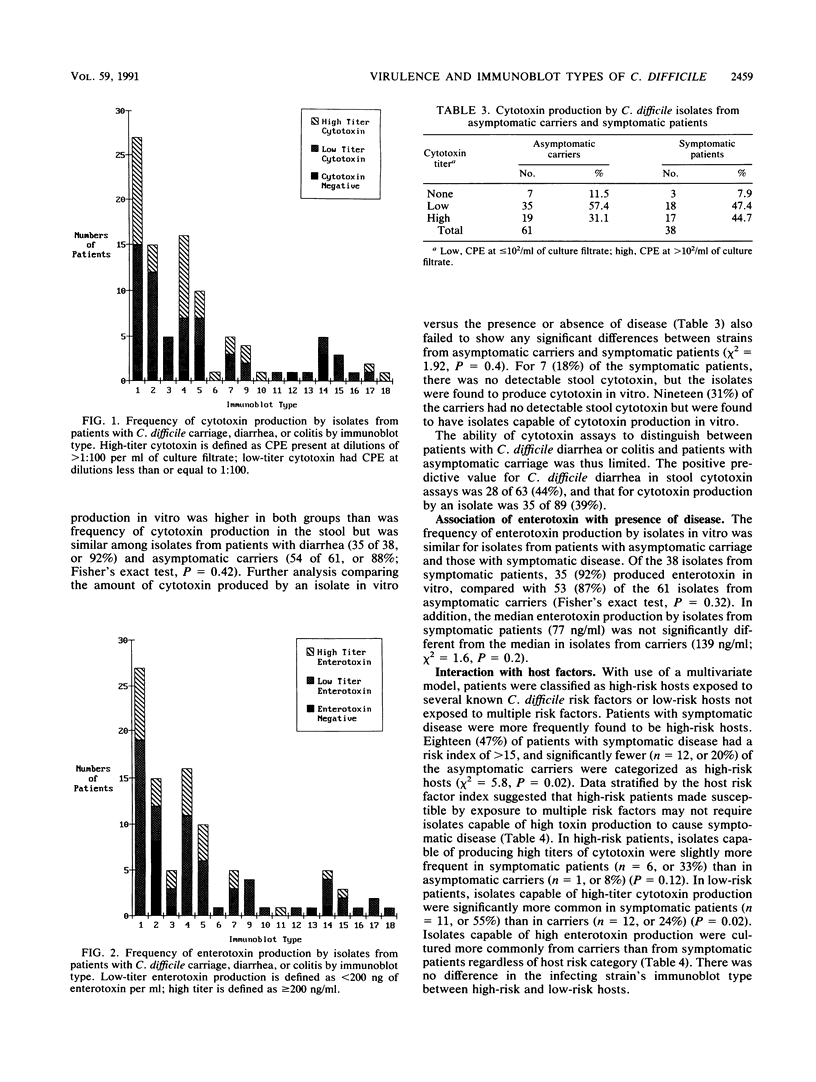
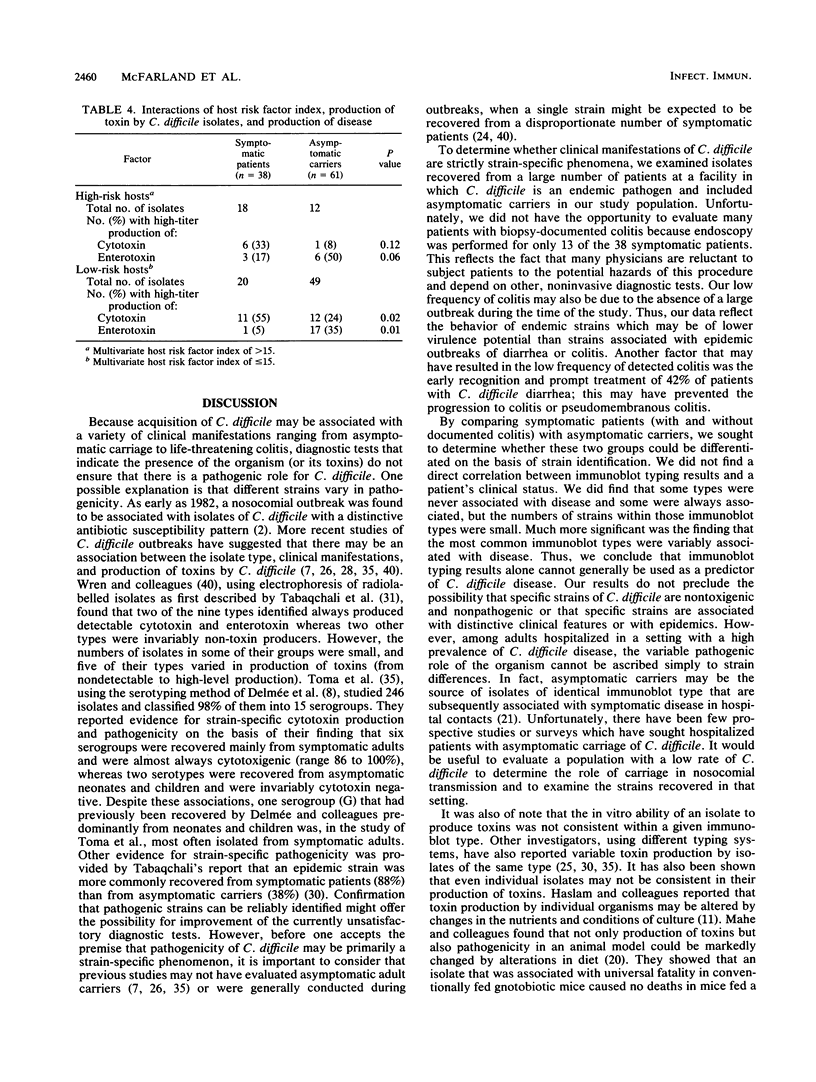
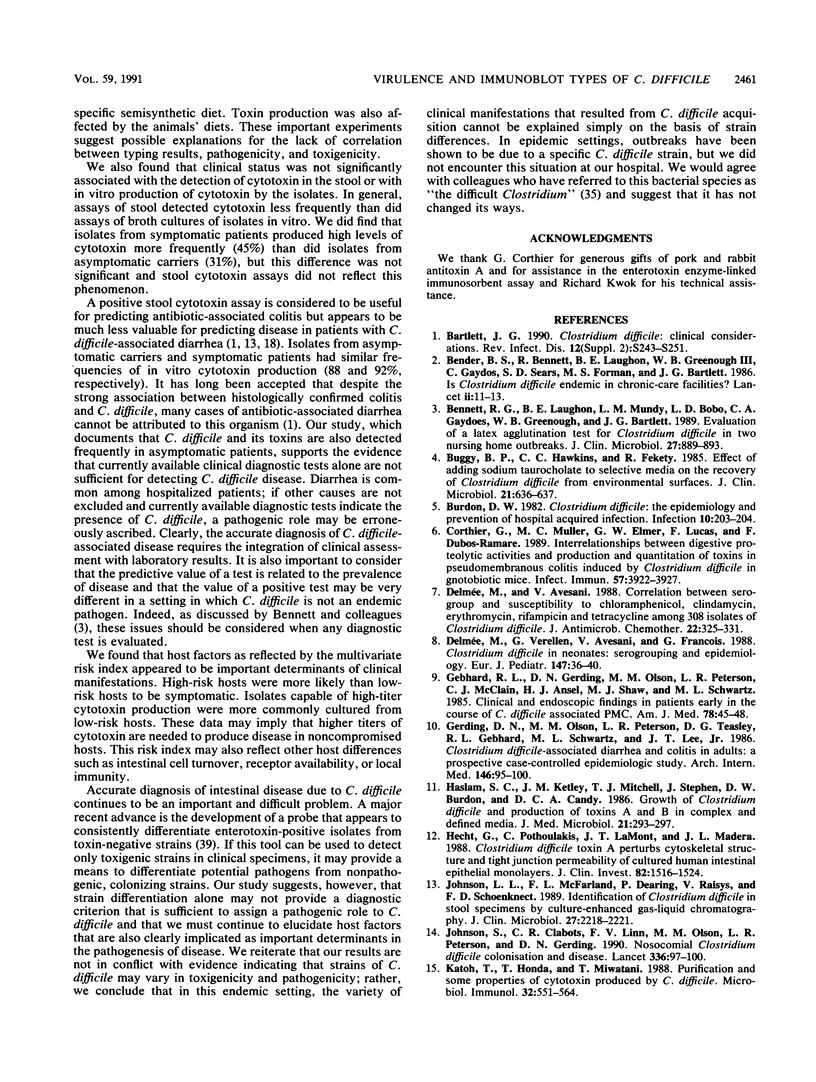
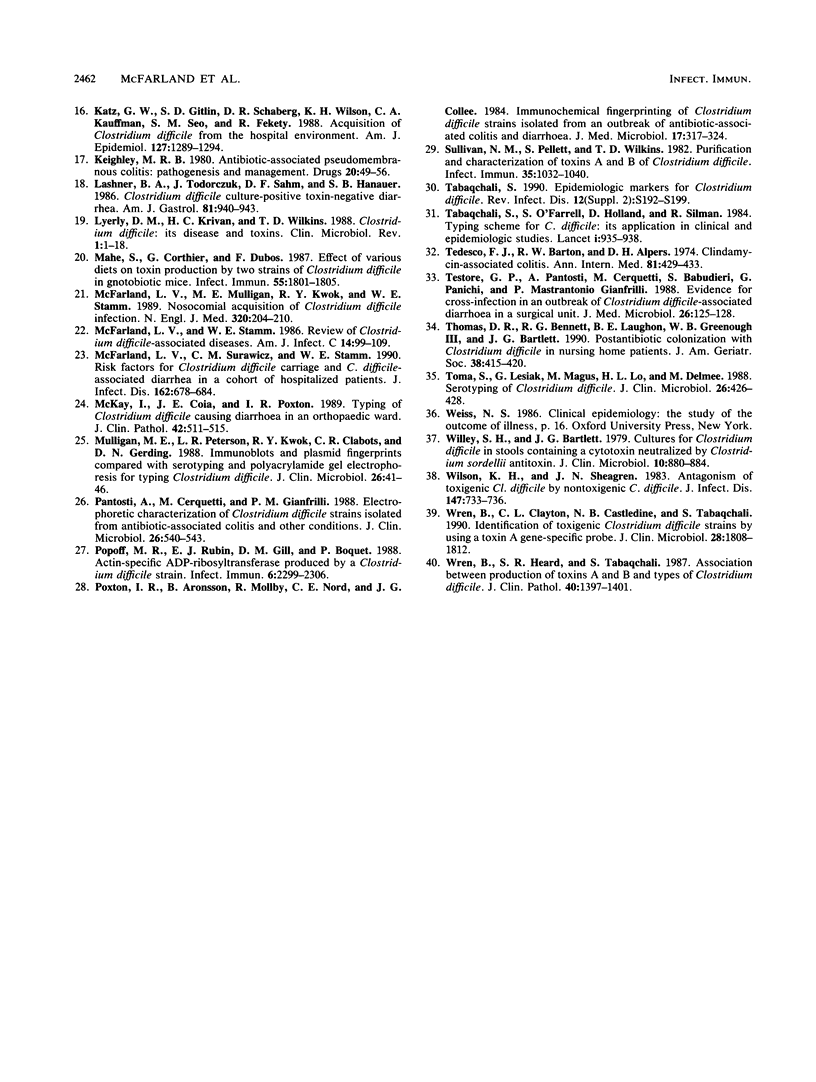
Selected References
These references are in PubMed. This may not be the complete list of references from this article.
- Bartlett J. G. Clostridium difficile: clinical considerations. Rev Infect Dis. 1990 Jan-Feb;12 (Suppl 2):S243–S251. doi: 10.1093/clinids/12.supplement_2.s243. [DOI] [PubMed] [Google Scholar]
- Bender B. S., Bennett R., Laughon B. E., Greenough W. B., 3rd, Gaydos C., Sears S. D., Forman M. S., Bartlett J. G. Is Clostridium difficile endemic in chronic-care facilities? Lancet. 1986 Jul 5;2(8497):11–13. doi: 10.1016/s0140-6736(86)92559-6. [DOI] [PubMed] [Google Scholar]
- Bennett R. G., Laughon B. E., Mundy L. M., Bobo L. D., Gaydos C. A., Greenough W. B., 3rd, Bartlett J. G. Evaluation of a latex agglutination test for Clostridium difficile in two nursing home outbreaks. J Clin Microbiol. 1989 May;27(5):889–893. doi: 10.1128/jcm.27.5.889-893.1989. [DOI] [PMC free article] [PubMed] [Google Scholar]
- Buggy B. P., Hawkins C. C., Fekety R. Effect of adding sodium taurocholate to selective media on the recovery of Clostridium difficile from environmental surfaces. J Clin Microbiol. 1985 Apr;21(4):636–637. doi: 10.1128/jcm.21.4.636-637.1985. [DOI] [PMC free article] [PubMed] [Google Scholar]
- Burdon D. W. Clostridium difficile: the epidemiology and prevention of hospital-acquired infection. Infection. 1982;10(4):203–204. doi: 10.1007/BF01666909. [DOI] [PubMed] [Google Scholar]
- Corthier G., Muller M. C., Elmer G. W., Lucas F., Dubos-Ramaré F. Interrelationships between digestive proteolytic activities and production and quantitation of toxins in pseudomembranous colitis induced by Clostridium difficile in gnotobiotic mice. Infect Immun. 1989 Dec;57(12):3922–3927. doi: 10.1128/iai.57.12.3922-3927.1989. [DOI] [PMC free article] [PubMed] [Google Scholar]
- Delmée M., Avesani V. Correlation between serogroup and susceptibility to chloramphenicol, clindamycin, erythromycin, rifampicin and tetracycline among 308 isolates of Clostridium difficile. J Antimicrob Chemother. 1988 Sep;22(3):325–331. doi: 10.1093/jac/22.3.325. [DOI] [PubMed] [Google Scholar]
- Delmée M., Verellen G., Avesani V., Francois G. Clostridium difficile in neonates: serogrouping and epidemiology. Eur J Pediatr. 1988 Jan;147(1):36–40. doi: 10.1007/BF00442608. [DOI] [PubMed] [Google Scholar]
- Gebhard R. L., Gerding D. N., Olson M. M., Peterson L. R., McClain C. J., Ansel H. J., Shaw M. J., Schwartz M. L. Clinical and endoscopic findings in patients early in the course of clostridium difficile-associated pseudomembranous colitis. Am J Med. 1985 Jan;78(1):45–48. doi: 10.1016/0002-9343(85)90460-7. [DOI] [PubMed] [Google Scholar]
- Gerding D. N., Olson M. M., Peterson L. R., Teasley D. G., Gebhard R. L., Schwartz M. L., Lee J. T., Jr Clostridium difficile-associated diarrhea and colitis in adults. A prospective case-controlled epidemiologic study. Arch Intern Med. 1986 Jan;146(1):95–100. [PubMed] [Google Scholar]
- Haslam S. C., Ketley J. M., Mitchell T. J., Stephen J., Burdon D. W., Candy D. C. Growth of Clostridium difficile and production of toxins A and B in complex and defined media. J Med Microbiol. 1986 Jun;21(4):293–297. doi: 10.1099/00222615-21-4-293. [DOI] [PubMed] [Google Scholar]
- Hecht G., Pothoulakis C., LaMont J. T., Madara J. L. Clostridium difficile toxin A perturbs cytoskeletal structure and tight junction permeability of cultured human intestinal epithelial monolayers. J Clin Invest. 1988 Nov;82(5):1516–1524. doi: 10.1172/JCI113760. [DOI] [PMC free article] [PubMed] [Google Scholar]
- Johnson L. L., McFarland L. V., Dearing P., Raisys V., Schoenknecht F. D. Identification of Clostridium difficile in stool specimens by culture-enhanced gas-liquid chromatography. J Clin Microbiol. 1989 Oct;27(10):2218–2221. doi: 10.1128/jcm.27.10.2218-2221.1989. [DOI] [PMC free article] [PubMed] [Google Scholar]
- Johnson S., Clabots C. R., Linn F. V., Olson M. M., Peterson L. R., Gerding D. N. Nosocomial Clostridium difficile colonisation and disease. Lancet. 1990 Jul 14;336(8707):97–100. doi: 10.1016/0140-6736(90)91605-a. [DOI] [PubMed] [Google Scholar]
- Kaatz G. W., Gitlin S. D., Schaberg D. R., Wilson K. H., Kauffman C. A., Seo S. M., Fekety R. Acquisition of Clostridium difficile from the hospital environment. Am J Epidemiol. 1988 Jun;127(6):1289–1294. doi: 10.1093/oxfordjournals.aje.a114921. [DOI] [PubMed] [Google Scholar]
- Katoh T., Honda T., Miwatani T. Purification and some properties of cytotoxin produced by Clostridium difficile. Microbiol Immunol. 1988;32(6):551–564. doi: 10.1111/j.1348-0421.1988.tb01417.x. [DOI] [PubMed] [Google Scholar]
- Keighley M. R. Antibiotic-associated pseudomembranous colitis: pathogenesis and management. Drugs. 1980 Jul;20(1):49–56. doi: 10.2165/00003495-198020010-00003. [DOI] [PubMed] [Google Scholar]
- Lashner B. A., Todorczuk J., Sahm D. F., Hanauer S. B. Clostridium difficile culture-positive toxin-negative diarrhea. Am J Gastroenterol. 1986 Oct;81(10):940–943. [PubMed] [Google Scholar]
- Lyerly D. M., Krivan H. C., Wilkins T. D. Clostridium difficile: its disease and toxins. Clin Microbiol Rev. 1988 Jan;1(1):1–18. doi: 10.1128/cmr.1.1.1. [DOI] [PMC free article] [PubMed] [Google Scholar]
- Mahe S., Corthier G., Dubos F. Effect of various diets on toxin production by two strains of Clostridium difficile in gnotobiotic mice. Infect Immun. 1987 Aug;55(8):1801–1805. doi: 10.1128/iai.55.8.1801-1805.1987. [DOI] [PMC free article] [PubMed] [Google Scholar]
- McFarland L. V., Mulligan M. E., Kwok R. Y., Stamm W. E. Nosocomial acquisition of Clostridium difficile infection. N Engl J Med. 1989 Jan 26;320(4):204–210. doi: 10.1056/NEJM198901263200402. [DOI] [PubMed] [Google Scholar]
- McFarland L. V., Stamm W. E. Review of Clostridium difficile-associated diseases. Am J Infect Control. 1986 Jun;14(3):99–109. doi: 10.1016/0196-6553(86)90018-0. [DOI] [PubMed] [Google Scholar]
- McFarland L. V., Surawicz C. M., Stamm W. E. Risk factors for Clostridium difficile carriage and C. difficile-associated diarrhea in a cohort of hospitalized patients. J Infect Dis. 1990 Sep;162(3):678–684. doi: 10.1093/infdis/162.3.678. [DOI] [PubMed] [Google Scholar]
- McKay I., Coia J. E., Poxton I. R. Typing of Clostridium difficile causing diarrhoea in an orthopaedic ward. J Clin Pathol. 1989 May;42(5):511–515. doi: 10.1136/jcp.42.5.511. [DOI] [PMC free article] [PubMed] [Google Scholar]
- Mulligan M. E., Peterson L. R., Kwok R. Y., Clabots C. R., Gerding D. N. Immunoblots and plasmid fingerprints compared with serotyping and polyacrylamide gel electrophoresis for typing Clostridium difficile. J Clin Microbiol. 1988 Jan;26(1):41–46. doi: 10.1128/jcm.26.1.41-46.1988. [DOI] [PMC free article] [PubMed] [Google Scholar]
- Pantosti A., Cerquetti M., Gianfrilli P. M. Electrophoretic characterization of Clostridium difficile strains isolated from antibiotic-associated colitis and other conditions. J Clin Microbiol. 1988 Mar;26(3):540–543. doi: 10.1128/jcm.26.3.540-543.1988. [DOI] [PMC free article] [PubMed] [Google Scholar]
- Popoff M. R., Rubin E. J., Gill D. M., Boquet P. Actin-specific ADP-ribosyltransferase produced by a Clostridium difficile strain. Infect Immun. 1988 Sep;56(9):2299–2306. doi: 10.1128/iai.56.9.2299-2306.1988. [DOI] [PMC free article] [PubMed] [Google Scholar]
- Poxton I. R., Aronsson B., Möllby R., Nord C. E., Collee J. G. Immunochemical fingerprinting of Clostridium difficile strains isolated from an outbreak of antibiotic-associated colitis and diarrhoea. J Med Microbiol. 1984 Jun;17(3):317–324. doi: 10.1099/00222615-17-3-317. [DOI] [PubMed] [Google Scholar]
- Sullivan N. M., Pellett S., Wilkins T. D. Purification and characterization of toxins A and B of Clostridium difficile. Infect Immun. 1982 Mar;35(3):1032–1040. doi: 10.1128/iai.35.3.1032-1040.1982. [DOI] [PMC free article] [PubMed] [Google Scholar]
- Tabaqchali S. Epidemiologic markers of Clostridium difficile. Rev Infect Dis. 1990 Jan-Feb;12 (Suppl 2):S192–S199. doi: 10.1093/clinids/12.supplement_2.s192. [DOI] [PubMed] [Google Scholar]
- Tabaqchali S., Holland D., O'Farrell S., Silman R. Typing scheme for Clostridium difficile: its application in clinical and epidemiological studies. Lancet. 1984 Apr 28;1(8383):935–938. doi: 10.1016/s0140-6736(84)92392-4. [DOI] [PubMed] [Google Scholar]
- Tedesco F. J., Barton R. W., Alpers D. H. Clindamycin-associated colitis. A prospective study. Ann Intern Med. 1974 Oct;81(4):429–433. doi: 10.7326/0003-4819-81-4-429. [DOI] [PubMed] [Google Scholar]
- Testore G. P., Pantosti A., Cerquetti M., Babudieri S., Panichi G., Gianfrilli P. M. Evidence for cross-infection in an outbreak of Clostridium difficile-associated diarrhoea in a surgical unit. J Med Microbiol. 1988 Jun;26(2):125–128. doi: 10.1099/00222615-26-2-125. [DOI] [PubMed] [Google Scholar]
- Thomas D. R., Bennett R. G., Laughon B. E., Greenough W. B., 3rd, Bartlett J. G. Postantibiotic colonization with Clostridium difficile in nursing home patients. J Am Geriatr Soc. 1990 Apr;38(4):415–420. doi: 10.1111/j.1532-5415.1990.tb03539.x. [DOI] [PubMed] [Google Scholar]
- Toma S., Lesiak G., Magus M., Lo H. L., Delmée M. Serotyping of Clostridium difficile. J Clin Microbiol. 1988 Mar;26(3):426–428. doi: 10.1128/jcm.26.3.426-428.1988. [DOI] [PMC free article] [PubMed] [Google Scholar]
- Willey S. H., Bartlett J. G. Cultures for Clostridium difficile in stools containing a cytotoxin neutralized by Clostridium sordellii antitoxin. J Clin Microbiol. 1979 Dec;10(6):880–884. doi: 10.1128/jcm.10.6.880-884.1979. [DOI] [PMC free article] [PubMed] [Google Scholar]
- Wilson K. H., Sheagren J. N. Antagonism of toxigenic Clostridium difficile by nontoxigenic C. difficile. J Infect Dis. 1983 Apr;147(4):733–736. doi: 10.1093/infdis/147.4.733. [DOI] [PubMed] [Google Scholar]
- Wren B. W., Clayton C. L., Castledine N. B., Tabaqchali S. Identification of toxigenic Clostridium difficile strains by using a toxin A gene-specific probe. J Clin Microbiol. 1990 Aug;28(8):1808–1812. doi: 10.1128/jcm.28.8.1808-1812.1990. [DOI] [PMC free article] [PubMed] [Google Scholar]
- Wren B., Heard S. R., Tabaqchali S. Association between production of toxins A and B and types of Clostridium difficile. J Clin Pathol. 1987 Dec;40(12):1397–1401. doi: 10.1136/jcp.40.12.1397. [DOI] [PMC free article] [PubMed] [Google Scholar]


